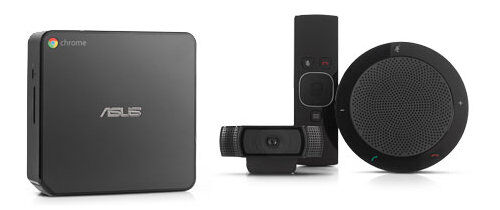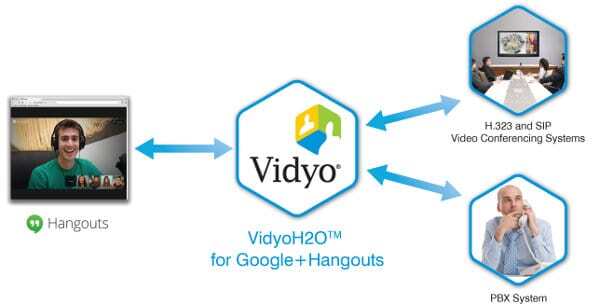Google is at it again. Trying to get into the enterprise with a video conferencing system.
A few years back, Google introduced Google Talk. Then they added video to it. At that point in time, I am sure that a meeting was held at the ivory tower of each video conferencing player.
The meeting probably went on like this:
– “We all know Google is the elephant in the room so let’s talk about it.”
– “They just launched a video calling system and in the cloud no less. We’re doomed!”
– “But where is their room system? It won’t work without it.”
– “And that multipoint conference they do – without having 2×2 and 3×3 layout of continuous presence, customers won’t be convinced.”
– “Where is the support? Google can’t offer that to customers. It isn’t in their nature or DNA.”
– “True. Google doesn’t understand enterprise. They do consumers, and even there, the only money they make is from search.”
– “Great. So that sums it up. Business as usual. Let’s go add to our new MCU device another layout – one that looks like what Google offered and we can definitely beat them.”
–
Well… all was true. And most probably still is. But there’s a question – what are customers really looking for.
Now all has changed. There have been 3 separate announcements going out last week, al related to Google’s Hangouts service and to the enterprise video conferencing market.
Google’s Chromebox
Google Chrombox is a video conferencing “room system” for Hangouts. $999 in price. A box, camera, microphone and remote control. Best post I’ve read during the weekend about it? The one by Michael Graves: Google Introduces Chromebox for Meetings

The meeting that happened last week on Friday at the ivory towers of the enterprise video conferencing company?
– “Chromebox will kill our room system offering. It costs just $999!”
– “But the camera. It isn’t PTZ. No way to shift it in the room. Our customers can’t use that.”
– “And their line of products is still lacking a telepresence system. An incomplete portfolio means they are going to fail.”
Some will say that this is important only for current Google enterprise customers, and won’t add any new ones. It certainly seem like that, by having a solution that can be less than interesting if you compare its specification to the enterprise video conferencing players. But there are a few things to remember here:
- The price is lower than most other players, and the product is good enough for most
- It is stupidly easy to install and deploy – something that is impossible to do with other vendors out there
- The hardware is commodity hardware, coming from multiple vendors. This isn’t specialized hardware. Traditional competitors will see this as a disadvantage, but this is a definite advantage for Google: The ability to switch vendors, offer multiple options with them, reliance on Intel as the one driving chip capabilities, putting this over the Chrome codebase, etc. This all puts the economies of scale that Google has into play
- The software itself. This is all cloud-based. Hangouts service, Chrome browser. It can get updated on a daily basis if Google decides. It can open up to a non-Hangouts audience with WebRTC. So many options are now available for Google – ones that are inaccessible to the other vendors
- It is a step towards commoditizing the enterprise video conferencing space. Even if Google isn’t a stellar success on this one – I’d be scared shitless if I were in that domain…
With this announcement, Google somewhat took the wind out of both Vidyo’s and Uberconference’s announcements.
Vidyo’s H2O
Vidyo announced a new product called VidyoH2O. Put simply, H2O is “Hangouts to Others” – a gateway to connect Google’s Hangout service to the other enterprise video conferencing systems (aka – legacy).

H2O stands for oxygen, and I’ll translate it to taking out the oxygen out of the legacy video conferencing vendors.
VidyoH2O will be released end of March, which means Google “forced” Vidyo to announce it just before Google announced Chromebox themselves.
This helps enterprises in two ways:
- If I am an enterprise on Google Apps using Hangouts, I will now be able to connect to legacy systems used by other enterprises. I can do this on premise by buying Vidyo’s product, or using it on Vidyo’s own data center
- If I am an enterprise with a legacy system, I can now connect to Hangouts by purchasing the new Google’s Chromebox. This is a nice transition path, where legacy investments are “saved”
For Vidyo, this has interesting implications:
- It positions them in both worlds: the WebRTC/Hangouts one as well as the legacy world. They are one of the only players today to offer such a transition
- It enables Vidyo to continue touting their cooperation with Google, and shows that their collaboration with Google on the VP9 codec isn’t a one-off thing, but rather is a piece of a larger strategy
- Vidyo will start offering hosted service for this one. It enables them to start eating up their own dog food and make a transition from a products vendor to a cloud/service vendor. This without pissing off some of their existing customers who offer hosted services
Kudos to Vidyo on taking these bold steps and on the great product name.
The best post about this new product/service belongs to Brent Kelly: Just Hanging Out
UberConference
If you never used UberConference for a voice call – you should try it out. It is a cleansing experience. UberConference announced their own integration with Hangouts. More about it in this video:
What it does, is add UberConference related capabilities (dial in, participants control, recording, etc) to a Hangout.
It adds several interesting capabilities:
- If you used UberConference, you can now use Hangouts instead and get the same set of features, with the following additions: video conferencing and accessibility from a smartphone or tablet using Google’s Hangouts app
- If you used Hangouts for conferences, then now people can dial in to the meeting (a common way of attending video meetings by phone today); AND you can have more controls over participants using the UberConference integration into the Hangouts session itself
This is a clear signal that Hangouts can be used in corporate environments and not only for pure video calling, but also for voice conferences.
Why is it important?
Enterprise Video conferencing is a 20 years failure. The industry makes money, but it is growing ridiculously slow compared to its consumer OTT counterparts. So disruption is imminent here.
Google taking its Hangouts consumer service, and putting it at the hands of enterprises is something that can change this market. Hopefully, it will smack a bit of sense into the other players there – make them a bit more creative and realistic in what they are doing.
I think it brings back my initial idea – my second WebRTC post here: the Post-WebRTC room system. Chromebox is the closest one to it, and with the help if Vidyo and UberConference, it is now also suitable for deployment with enterprises who are running legacy systems.
–
UPDATE: Some readers reminded me that H2O is water and not oxygen. I have but two things to say about it:
- I never did like chemistry, so it shows (and yes, it is stupid of me to miss it)
- So we’re not taking the oxygen out of the enterprise video conferencing market – we’re just drying it up instead

“Great. So that sums it up. Business as usual.”
If that is how people think, they are in for a surprise.
They should be thinking: what will be their next move. How will our offering compare then ?
It is hard to do that Lennie when you view things from within an industry. Too many “truths” and sacred cows out there to deal with.
I hope there is a middle ground between:
doing something which is really, really hard and ignoring the change coming down the pipe. 😉
Great post Tsahi. Thanks for laying it out so clearly.
“H2O stands for oxygen, and I’ll translate it to taking out the oxygen out of the legacy video conferencing vendors.” – First telepresence and now Google is changing the periodic table. Back in my day, H2O used to stand for water…
Patrick,
Check my update at the end of the post.
Never said I was smart – but a good way to think about it is this – WebRTC changes everything – including what stands for the basics of our knowledge and the chemistry of what enterprise video conferencing is – it changes oxygen into water and vice versa. 🙂
The big question for me is:
What type of company is the most natural to quickly create opportunity out of this?
The one that keeps coming to mind for me are those companies that work in the Google enterprise space. These are the people that help enterprise companies move away from Microsoft to Google. So when the end user says; “I love this collaboration solution and the price points but how do I figure out security? Are hangouts and Gmail really industrial strength and secure enterprise ready applications? Can I hire someone to help me catch this wave but make sure it is done in quality and secure way?”
Google is known for its innovative things and ideas and developing enterpise video conferencing system is a new feather in google products suite. Apart from google and uberconference video conferencing system, tools like R-HUB desktop video conferencing servers, webex, gomeetnow, gotomeeting etc. can also be used for conducting online conferences.